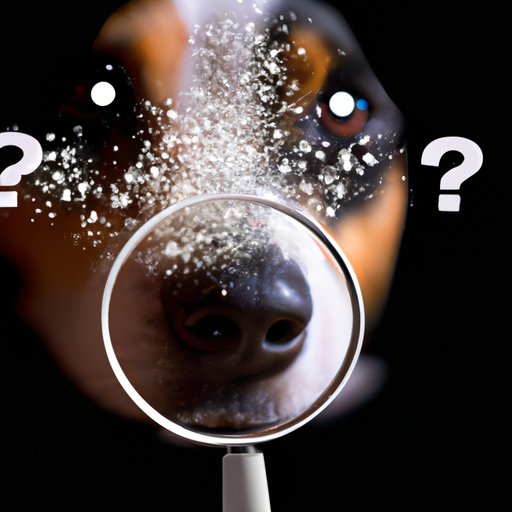Dogs have long been celebrated for their incredible sense of smell, a trait that has made them indispensable partners for humans in a variety of fields. From sniffing out drugs and explosives to tracking down lost individuals and even detecting cancers, dogs’ noses are truly extraordinary sensory organs. But just how sensitive is a dog’s nose, really? In this comprehensive guide, we delve into the science of canine olfaction and explore the fascinating world that our four-legged friends experience through their noses.
Key Takeaways:
- Dogs have a sense of smell that is between 10,000 and 100,000 times more sensitive than humans.
- A dog’s brain is specialized for identifying scents.
- Dogs use their sense of smell to communicate, navigate, and detect danger.
- Training and breed can affect a dog’s scent capabilities.
Table of Contents:
- Understanding the Canine Nose
- The Science Behind a Dog’s Smell
- How Dogs Use Their Sense of Smell
- Factors That Influence a Dog’s Sense of Smell
- Frequently Asked Questions
Understanding the Canine Nose
A dog’s nose is a complex piece of biological machinery. The moist, spongy outside part of a dog’s nose, known as the rhinarium, is designed to capture scent particles. Inside, a dog’s nasal cavity is divided into two passages that will lead air into two separate areas of the nose for scent and respiration.
The dimension of a dog’s nose varies by breed, but regardless of size, their noses are ultra-sensitive. One Top Dog provides a wealth of information on different dog breeds and their unique characteristics, including their sense of smell.
The Science Behind a Dog’s Smell
The incredible sensitivity of a dog’s nose is due to the number of olfactory receptors they have. Humans have about 6 million olfactory receptors, while dogs have a staggering 300 million. This massive difference explains why dogs can detect odors at concentrations nearly 100,000 times lower than humans can.
In addition to the number of receptors, a dog’s brain is also specialized for identifying scents. The part of a dog’s brain that processes smells is proportionally 40 times greater than ours. This gives them a remarkable ability to recognize and remember a vast array of scents.
How Dogs Use Their Sense of Smell
Dogs primarily use their sense of smell to understand the world around them. They use scent to communicate, navigate, find food, and detect danger.
Dogs can use their sense of smell to communicate with each other. Through pheromones, chemicals that are produced and released into the environment, dogs can share information about their reproductive status, territories, identities, and more.
Navigation is another important use of a dog’s nose. Dogs can create a mental map of their environment based on the smells present, allowing them to navigate even in unfamiliar areas. This is why dogs are often able to find their way home even from great distances.
Dogs also use their noses to find food. They can detect the smell of food many yards away and will often follow their nose to locate a tasty treat.
Finally, dogs use their sense of smell to detect danger. This can range from smelling a predator in the wild to detecting smoke in a house fire.
Factors That Influence a Dog’s Sense of Smell
Several factors can influence a dog’s sense of smell. These include the breed of the dog, their training, and environmental factors.
Different breeds have different scenting abilities. Some breeds, like Bloodhounds and Basset Hounds, are known for their exceptional olfactory capabilities, while others have a more average sense of smell.
Training can also play a significant role in a dog’s scenting abilities. Dogs trained in scent work, like search and rescue dogs or drug detection dogs, have their sense of smell honed to an incredible degree. They are trained to discriminate between different scents and to alert their handlers to the presence of specific odors.
Environmental factors can also impact a dog’s sense of smell. Weather conditions, temperature, and humidity can all affect how well a dog can detect and identify odors.
Frequently Asked Questions
Q: Can dogs smell fear?
A: While it’s a common belief that dogs can smell fear, it’s not entirely accurate. Dogs are sensitive to changes in body chemistry, and when we’re scared, our bodies do release chemicals like adrenaline, which a dog might pick up on. However, saying dogs smell fear may be oversimplifying a complex interaction of body language and chemical signals.
Q: Can dogs smell cancer?
A: There is growing evidence to suggest that dogs can be trained to detect certain types of cancer by smell. Several studies have reported that trained dogs can detect cancer with a high degree of accuracy.
Q: How far can a dog smell?
A: The range of a dog’s sense of smell depends on many factors, including the breed, weather conditions, and the type of scent. However, it’s generally believed that dogs can detect scents from miles away.
To learn more about the amazing abilities of dogs, check out these articles from One Top Dog:
Remember, every dog is unique, and their abilities can vary significantly from one dog to another. However, it’s safe to say that all dogs have a sense of smell that is truly remarkable.



